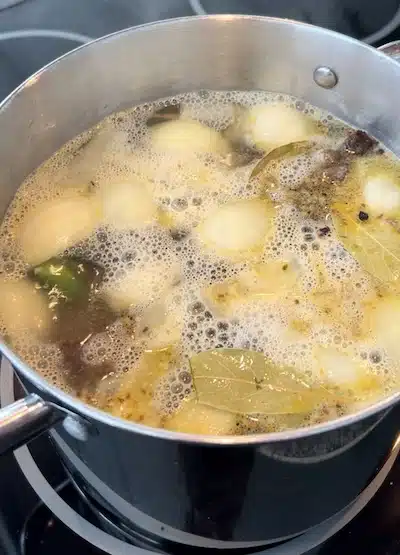
Bone Broth for Healing and Longevity
Bone broth has been a staple in ancestral kitchens across cultures for centuries — and for good reason. People made nourishing broths with healing compounds by simmering bones, herbs, and vegetables for hours before protein powders and multivitamins flooded our shelves.
Bone broth is currently experiencing a well-earned renaissance, not only in kitchens but also in functional medicine, wellness regimens, and biohacking communities. Rich in collagen, minerals, and amino acids, it promotes immunity, skin resilience, joint strength, gut health, and even better sleep.
As someone who’s deeply invested in longevity and nourishment from the inside out, I make my own bone broth regularly. It’s simple, grounding, and one of the easiest ways to give your body deep, foundational support.
What is Bone Broth?
Bone broth is a nutrient-rich liquid made by simmering animal bones (often with connective tissue and some meat) for a long period — usually 12–24 hours. The slow cooking process allows the bones and tissues to release beneficial compounds like:
– Collagen & gelatin – essential for skin, joints, and gut lining
– Glycine & proline – amino acids with anti-inflammatory and detoxifying effects
– Glucosamine & chondroitin – support joint and cartilage health
– Minerals – including calcium, magnesium, phosphorus, and potassium
– Electrolytes – for hydration and nervous system balance
Unlike traditional stocks or bouillon cubes, real bone broth is unprocessed and deeply nourishing.
A Global Tradition Rooted in Simplicity
Cultures all around the world have relied on broth-making to extract every last drop of nutrition from animals. Whether it’s chicken soup in Jewish culture, beef broth in Vietnamese pho, or fish head soups in Scandinavia, bone broth has always been more than food, it’s been medicine.
Rooted in simplicity. Backed by tradition.
Making your own bone broth forces you to slow down and reconnect with something primal — and in today’s fast-paced world, that’s a powerful act of self-care.
Why Bone Broth Belongs in Your Longevity Toolbox
Here are just a few of the research-backed reasons to drink bone broth regularly:
Gut Repair & Digestive Health
Gelatin and collagen help seal the gut lining, making broth a go-to for anyone with leaky gut, bloating, IBS, or inflammation.
Stronger Skin, Hair & Nails
Collagen supports skin elasticity, reduces dryness, and may improve hair and nail strength over time.
Joint & Bone Support
Bone broth contains natural compounds like glucosamine and chondroitin — often found in joint supplements — that reduce stiffness and support mobility.
Better Sleep & Relaxation
Glycine, a key amino acid in broth, has been shown to improve sleep quality and promote a calm nervous system.
Immunity
The combination of amino acids, minerals, and gelatin can support immune resilience — particularly helpful during the colder seasons or after illness.
My Bone Broth Recipe 🌿

I’ve been making bone broth at home for years, and this is the simple method I always come back to. I typically drink 1–2 cups daily, especially on rest days or mornings.
Ingredients:
– 1 kg grass-fed beef bones (knuckle bones, marrow bones, or mixed)
– 3 carrots
– 4 onions
– 3 celery stalks
– 2 garlic cloves
– 2 cinnomon sticks
– 3 bay leafs
– 10 whole black peppercorns
– A pinch of star anise
Instructions:
1. Roast the bones
Preheat your oven to 220°C (390°F). Roast the bones for about 30 minutes or until they’re nicely browned. This step deepens the flavor.
2. Prep the veggies
Roughly chop carrots, onions, and celery into large chunks.
3. Brown the vegetables
Sauté the chopped vegetables in a large pot with a bit of coconut fat until slightly golden and fragrant.
4. Combine everything
Add the roasted bones, sautéed veggies, garlic, spices, and herbs to the pot.
5. Add water
Fill the pot with water just enough to cover the bones and vegetables.
6. Simmer low & slow
Bring to a boil, then reduce to a gentle simmer. Skim off any foam or fat that rises to the top during cooking.
7. Let it simmer
Allow the broth to simmer for 12–48 hours. The longer, the better! Refill with water if it reduces too much. (If needed, you can pause the process overnight — just turn off the heat, let it cool, store it safely, and continue simmering the next day.)
8. Strain & store
When done, strain out the bones and vegetables. Let cool and store in glass jars in the fridge or freezer.
Tip: Once cooled, your broth should have a jelly-like consistency — a good sign that it’s rich in collagen!
👉 You can download the recipe and instructions here.
FAQ Bone Broth
Yes! After your first batch, you can add fresh water and simmer the bones again for a second, lighter broth. It won’t be as gelatin-rich, but it still contains minerals and flavor.
Many people benefit from 1–2 cups daily, especially in the morning or before meals. You can also use it in soups, sauces, or as a cooking base for added nourishment.
Traditional bone broth is not vegetarian. However, you can make a mineral-rich vegetable broth with seaweed (for iodine), mushrooms, garlic, and root vegetables. While it won’t contain collagen, it can still be grounding and healing.
Yes — bone broth freezes very well. Store it in glass jars (leave room at the top for expansion) or pour into silicone molds or ice cube trays for smaller portions.

Perfect Keto Grass-Fed Collagen with MCT
Offer: Use code KAJSA for 20% off your first order.
Don’t have time to make bone broth?
No problem. Perfect Keto’s Grass-Fed Collagen with MCT is a convenient way to support your skin, joints, gut, and energy — even on your busiest days. With hydrolyzed collagen peptides and MCT oil for brain fuel, this is a delicious and easy way to get your daily collagen boost.
I use it in my coffee, smoothies, or even as a simple shake — especially when I’m traveling or don’t have fresh broth on hand.
Summary
Bone broth may be old-fashioned, but its benefits are more relevant than ever. It’s cost-effective, deeply nourishing, and aligned with both ancestral wisdom and modern science.
In a world full of quick fixes and synthetic solutions, broth offers something different: real nourishment, from real food, made with care.
So if you’re looking for a ritual that supports your gut, your skin, your energy, and your aging process — start with a pot of bones. And when you do, make sure you choose organic and grass-fed bones — to nourish your body while also protecting our animals and the environment.



